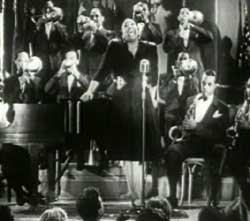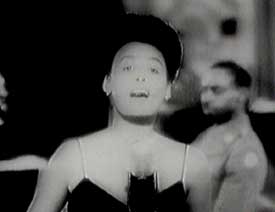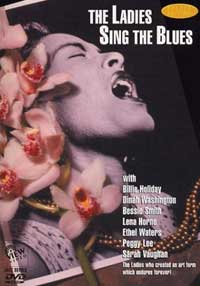 One hour of clips together with superficial narration, The Ladies Sing the blues (1989) is pleasant, idle viewing with some undeniably good music, thought most of the material sampled is available elsewhere, & in its entirety, without a lame narrator talking over the performances. One hour of clips together with superficial narration, The Ladies Sing the blues (1989) is pleasant, idle viewing with some undeniably good music, thought most of the material sampled is available elsewhere, & in its entirety, without a lame narrator talking over the performances.
This documentary discusses & shows a fragment of Bessie Smith's only film appearance, in St. Louis Blues (1929). It incorporates Ethel Waters' "Darkies Never Dream" from Bubbling Over (1934), plus Ethel with the Count Basie Orchestra singing "Quicksand" from Stage Door Canteen (1943); & a clip of Billie Holiday with Count Basie, excerpted from 'Sugar Chile' Robinson, Billie Holday, Count Basie & His Sextet (1951). This is all tremendous material, but even better in the context of the complete films.
There are two clips of Lena Horne, singing "Unlucky Woman" backed by the Teddy Wilson Orchestra from the one-reel musical comedy Boogie Woogy Dream (1944), & "The Man I Love" very washed out poor copy, from the Armed Forces short film Jubilee: G. I. Journal (1942) backed by Jimmie Lunceford & His Orchestra in their uniforms.
 The Broadway musical Lady Be Good was from 1928, & "The Man I Love" was already a standard by the time of the feature film, with the best version by Billie Holiday, & a couple later versions done awfully well by Memphis Minnie, Sarah Vaughan, Peggy Lee, & Ella Fitzgerald. Lena's & Billie's probably remained best, & Minnie's the most unique. The Broadway musical Lady Be Good was from 1928, & "The Man I Love" was already a standard by the time of the feature film, with the best version by Billie Holiday, & a couple later versions done awfully well by Memphis Minnie, Sarah Vaughan, Peggy Lee, & Ella Fitzgerald. Lena's & Billie's probably remained best, & Minnie's the most unique.
None of that sort of information is provided by the documentary. Indeed, for all this material, the sources are not provided anywhere with the documentary, which will frustrate many viewers who want to see the complete performances & films. In most cases it would be easy to find the full versions but it might be hard for some viewers to know what to look for. In this review I've tried to repair the documentary's appalling lack of credits.
A very few things would be harder to find with or without the needed info on tracking it down. There are two delightful clips featuring Ida Cox, along with her husband Jessie Crump on piano. Ida is singing "When You Lose Your Money Blues" from her only film appearance in Woman's a Fool (1948).
Sister Rosetta Tharpe is shown in the lively, brilliant soundie Lonesome Road (1941) singing with Lucky Millinder's orchestra.
Most of the artists included are black women, but a couple white women find their way into the grouping, apparently quite randomly depending on what was available out of copyright requiring no permissions. Connee Boswell was not a blues singer so a very odd choice; & though she was great in her own right, her Snader telescriptions don't show her at her best. Yet she's tossed in with better material no doubt because the little film was available free.
So we see Connee Boswell in Nobody's Sweetheart (1952), a film that in its entirety was less than three minutes long. Yet in this cheapo documentary, not only could they not find room for the whole thing, but the narrator talks over the whole fragment.
The narrator is not so offending after introducing Dinah Washington's Studio Telescriptions My Lean Baby & Only a Moment Ago (1954).
The narrator also shuts his annoying yap after introducing the Studio telescripton Ruth Brown's Have a Good Time (1954), although not before repeating the canard that this performance was at the Apollo Theater in Harlem. It was recorded on the Studio Films soundstage pretending to be the Apollo. So while none of these clips & mini-films are credited as to date or source or location, when for once it does provide an ounce more than the most superficial information, it's completely wrong.
Coming in on the close the documentary's last bits splice in will include one of the Sarah Vaughn Snader telescriptions You're Mine, You! (1951); Helen Humes & the Count Basie Orchestra in the Snader telescription I Cried for You (1951).
The narrator talks over a fragment of Peggy's Snader telescription I Only Have Eyes for You (1951) then shuts up so we can actually hear "Why Don't You Do Right By Me" from The Powers Girl (1943) singing for Benny Goodman. And last of the last is another Snader telescription I Cover the Waterfront (1950) with Peggy Lee alongside her husband guitarist Dave Barbour.
In all, sixteen performances are sewn into this one-hour documentary, & it wouldn't be totally boring to give it an hour of your life, especially if expectations are held at the lowest for presentation & information. It's really very little more than a random compilation of clips & short-shorts posing as a documentary on the subject.
copyright © by Paghat the Ratgirl
|

